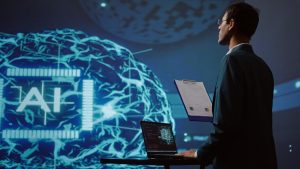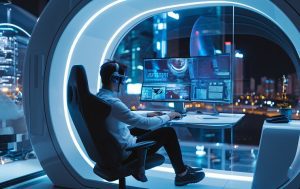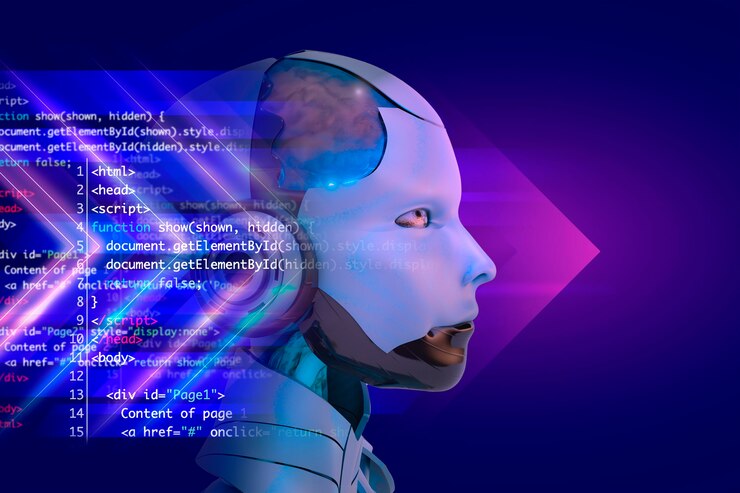In today’s hyper-connected world, where data breaches and cyberattacks pose constant threats to businesses and governments, artificial intelligence in cybersecurity has emerged as a crucial defense mechanism. As cybercriminals continue to evolve their tactics, AI technologies are helping security professionals stay one step ahead. By automating threat detection, streamlining security processes, and minimizing human error, AI in cybersecurity offers a robust solution to a growing global challenge.
The Rise of AI in Cybersecurity

Artificial intelligence in cybersecurity is transforming the way organizations approach security, offering faster detection and response to cyber threats. AI-enabled software can process vast amounts of data in real time, identifying anomalies and potential threats that would otherwise go unnoticed by human analysts. For instance, machine learning algorithms can rapidly identify new types of malware and hacking attempts, evolving their defenses over time as threats become more sophisticated.
Case Study: Darktrace’s AI Solution
A prime example of AI-driven cybersecurity is Darktrace, which uses AI to detect, analyze, and respond to cyber threats in real time. Darktrace’s “Enterprise Immune System” mimics the human immune system, identifying suspicious activities and autonomously responding to potential threats, reducing the need for human intervention. Darktrace has proven effective in preventing malware attacks across various industries, demonstrating how AI can act as an essential layer of defense.
Key Market Drivers and Growth Trends
The AI cybersecurity market is on a trajectory of rapid growth, driven by a few key factors:
- Surging demand for advanced cybersecurity solutions: With cyberattacks becoming more frequent and sophisticated, companies are investing in robust AI-based security systems.
- Growing use of social media for business operations: As businesses expand their digital footprint on social platforms, the need for advanced AI cybersecurity solutions grows, given the vulnerabilities in these platforms.
- Government investments in AI: Several governments worldwide are investing in AI technologies to strengthen national cybersecurity infrastructures.
According to market forecasts, the AI cybersecurity market is expected to grow at a CAGR of 27.8% from 2022 to 2030, highlighting the increasing reliance on AI to combat cyberattacks.
Challenges in AI Cybersecurity Adoption
Despite the potential, the AI cybersecurity sector faces some challenges:
- Lack of skilled AI professionals: The shortage of experts capable of developing and maintaining AI cybersecurity systems is a significant barrier to adoption.
- Limited cybersecurity budgets: Many small and medium enterprises (SMEs) lack the financial resources to invest in cutting-edge AI solutions, leaving them vulnerable to attacks.
How Hackers Abuse AI: The Dark Side of Artificial Intelligence
Artificial intelligence (AI) is revolutionizing industries, driving innovation, and improving efficiency across many sectors. However, just as AI has been adopted to protect against cyber threats, hackers are also leveraging AI for malicious purposes. Cybercriminals are relentless and resourceful, constantly seeking ways to exploit this technology for their own benefit. In this article, we’ll examine several ways hackers are using AI to enhance their attacks and create new forms of cybercrime.
1. Social Engineering Schemes Enhanced by AI
Social engineering schemes rely on psychological manipulation to trick individuals into revealing sensitive information or making security mistakes. These schemes can range from phishing and vishing to business email compromise (BEC) scams, all designed to deceive victims into providing valuable data or access.
With AI, cybercriminals are automating many of the processes used in social engineering attacks. AI tools can generate personalized, sophisticated, and highly effective messaging, increasing the likelihood of success. This includes creating emails or text messages that seem legitimate and relevant to the recipient, making it much harder to identify as a scam.
AI’s ability to analyze large amounts of personal data (often harvested through data breaches or social media) allows hackers to create targeted attacks, sometimes referred to as “spear-phishing.” These targeted messages appear highly credible, increasing the success rate of the attack. Moreover, by automating the process, cybercriminals can generate a greater volume of attacks in less time, maximizing the scale and efficiency of their operations.
Example: In 2020, cybercriminals used AI to conduct sophisticated phishing campaigns that mimicked official communication from government agencies regarding COVID-19 relief efforts. These messages tricked victims into sharing personal data or making payments.
2. Password Hacking Powered by AI
Passwords are the first line of defense for most online accounts, but cybercriminals are increasingly using AI to enhance their password hacking efforts. Traditionally, hackers used brute force attacks, attempting to guess passwords by trying millions of combinations. However, AI-powered algorithms have made this process faster and more accurate.
AI can analyze commonly used passwords and patterns in human behavior to predict password combinations more effectively. By improving their algorithms with AI, cybercriminals can break into accounts more quickly and with greater precision. This is particularly concerning given the ongoing problem of weak passwords and reused credentials across multiple accounts.
Example: In 2019, security researchers demonstrated that an AI-driven password-cracking algorithm was able to guess 25% of passwords within just three seconds. As AI technology advances, the efficiency of these attacks is likely to increase.
3. Deepfakes: AI’s Role in Deception
Deepfakes are another area where hackers are exploiting AI. A deepfake is a highly convincing but fabricated piece of visual or audio content. AI makes it easy to manipulate video or audio to create fake representations of individuals, which can then be used for various malicious purposes.
Cybercriminals can use deepfakes to impersonate others, especially public figures, company executives, or even personal acquaintances. This type of deception has been used in social engineering, extortion, and even corporate fraud. Deepfakes can create stress, fear, or confusion among their targets, leading them to make decisions or take actions they otherwise would not.
Example: In 2020, cybercriminals used deepfake audio to impersonate a company executive and instruct a subordinate to transfer large sums of money to a fraudulent account. The deepfake was so convincing that the employee believed they were speaking to their boss, resulting in significant financial losses.
4. Data Poisoning: Manipulating AI’s Learning Process
Data poisoning is one of the more technical but highly effective ways hackers can abuse AI. In this attack, cybercriminals “poison” the data that an AI algorithm uses for training. By feeding the algorithm deceptive or false data, they can influence the decisions it makes.
AI systems rely on large datasets to learn and make predictions. If hackers manipulate the data being used, they can cause the AI to make incorrect decisions, which could lead to vulnerabilities in systems that rely on AI for cybersecurity or decision-making.
Data poisoning attacks can be difficult and time-consuming to detect, meaning that by the time they are discovered, the damage could already be significant. These attacks can compromise the integrity of an AI model and undermine trust in AI-driven systems.
Example: In 2021, researchers demonstrated how data poisoning could be used to trick AI-based facial recognition systems. By manipulating the training data, hackers were able to cause the system to misidentify individuals, opening the door for potential security breaches.
Staying Secure in a Changing AI Environment
As AI continues to evolve, so do the concerns about data privacy and cybersecurity risks for individuals and businesses. Regulators are actively considering ways to develop AI technologies that maximize their benefits while minimizing negative societal impacts. However, comprehensive federal AI legislation in the United States has yet to be enacted, leaving a gap in regulation.
So, what does this mean for you? How do advancements in AI affect your life from a security perspective? While it may seem overwhelming, the answer is surprisingly simple: you don’t need to learn a completely new set of cybersecurity rules. Instead, focus on refining your current cybersecurity practices to stay protected against evolving threats.
Best Practices to Stay Secure Against AI-Driven Threats:
- Strong, Unique Passwords: Regularly update passwords and use complex combinations of letters, numbers, and symbols. Consider using a password manager to create and store strong passwords.
- Two-Factor Authentication (2FA): Implement 2FA for added security. Even if a hacker manages to crack your password, they won’t be able to access your accounts without a second form of authentication.
- Beware of Social Engineering: Be cautious of unsolicited emails, phone calls, or messages. Even if the message seems legitimate, always verify the sender’s identity before sharing personal information or taking action.
- Stay Informed: Regularly update your knowledge on the latest cybersecurity threats. As hackers adapt AI to their tactics, staying informed will help you better recognize and avoid these threats.
Case Study: Challenges Faced by SMEs
A recent study revealed that SMEs are particularly vulnerable to cyber threats due to their lack of AI-powered cybersecurity systems. A manufacturing company, for instance, experienced a ransomware attack that paralyzed operations for several days because they had outdated security software. The company’s inability to invest in AI solutions due to budget constraints left them vulnerable to this type of attack.
AI in Cybersecurity Market Segmentation
The global AI cybersecurity market is segmented based on several factors:
- By Offering: Software solutions dominate the market, with AI platforms offering network monitoring and security operations automation. These include machine learning algorithms that detect threats faster than traditional systems.
- By Technology: Machine Learning has gained the largest share due to its ability to analyze vast datasets and deliver predictions, while Natural Language Processing (NLP) and Context-Aware Computing are making inroads.
- By Deployment Model: Cloud-based solutions are growing due to their scalability and centralized approach to security.
- By Security Type: Network security and cloud security are leading, with the latter growing fastest as enterprises increasingly store data in the cloud.
Benefits of AI in Cybersecurity
- Improved Threat Detection: AI technologies identify potential threats much faster than traditional systems, reducing the response time to breaches.
- Scalability: AI can easily handle large networks, monitoring and protecting vast amounts of data and users.
- Reduced Human Error: By automating routine tasks, AI minimizes the chance of errors that could lead to vulnerabilities.
- Cost-Effective Solutions: AI platforms provide real-time monitoring, eliminating the need for a large team of cybersecurity professionals.
Case Study: IBM Watson in Cybersecurity
IBM Watson is an example of AI improving cybersecurity. It uses machine learning to help organizations detect threats and manage security incidents. A healthcare provider that implemented IBM Watson reported a 60% reduction in the time it took to identify and respond to potential threats.
Examples of AI Applications in Cybersecurity
- Antivirus/Antimalware: AI-powered antivirus solutions can quickly detect new malware strains before they cause damage.
- Fraud Detection and Identity & Access Management (IAM): AI helps in identifying suspicious transactions and unauthorized access to systems, preventing fraud.
- Threat Intelligence: AI gathers data from multiple sources to provide insights into potential threats, allowing organizations to preemptively block attacks.
Regional Analysis and Market Outlook

The North American region leads the market due to significant investments in AI cybersecurity solutions. Asia-Pacific is expected to see the fastest growth due to the increasing number of cyberattacks, particularly in countries like China and India.
Analysis Table: AI Cybersecurity Market by Region (2022-2030)
| Region | Market Share (%) | Growth Rate (CAGR) |
|---|---|---|
| North America | 35% | 25.5% |
| Europe | 28% | 26.1% |
| Asia-Pacific | 22% | 29.8% |
| Latin America | 10% | 22.5% |
| MEA | 5% | 20.2% |
Future Opportunities for AI in Cybersecurity
As the world becomes more connected, the demand for AI cybersecurity solutions will continue to grow, especially in protecting IoT devices, which are increasingly targeted by cybercriminals. Industries such as healthcare, finance, and retail are expected to adopt AI cybersecurity systems at an accelerated rate.
Case Study: Palo Alto Networks
Palo Alto Networks has leveraged AI to enhance its security operations. Their AI-based Cortex platform allows for automatic threat detection and response, helping organizations manage security incidents more efficiently.
Conclusion
Artificial intelligence is revolutionizing cybersecurity, offering organizations faster and more accurate methods to detect and prevent threats. As cybercriminals continue to evolve, so too must the technologies used to combat them. The future of AI in cybersecurity is promising, with growing investments, technological advancements, and an increasing number of businesses adopting AI-driven solutions to protect their data and infrastructure.
AI is a powerful tool that offers immense potential for both cybersecurity defenses and the attackers trying to breach them. Cybercriminals are finding new ways to exploit AI, but with the right precautions and knowledge, individuals and organizations can stay one step ahead.












